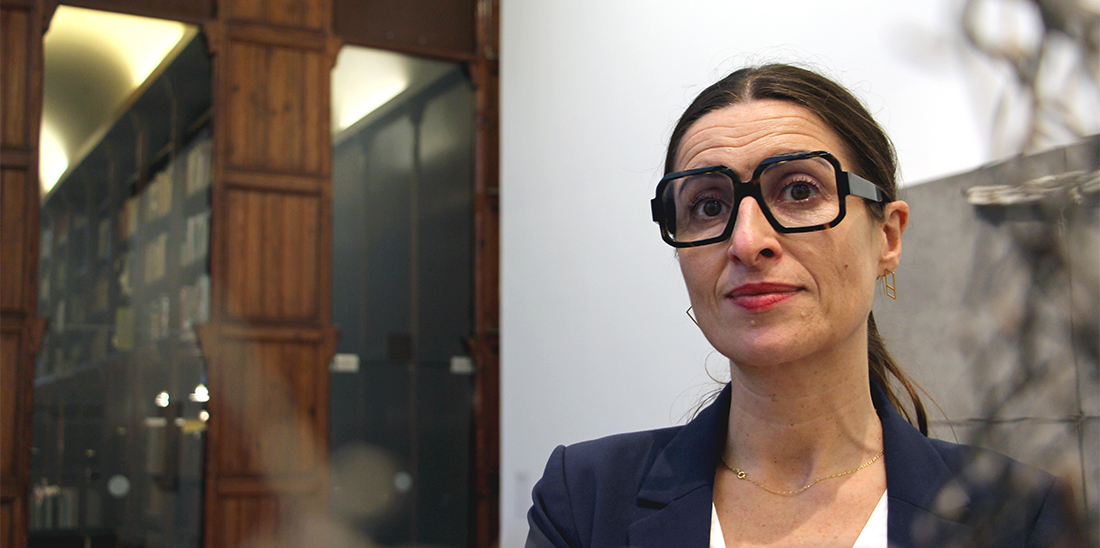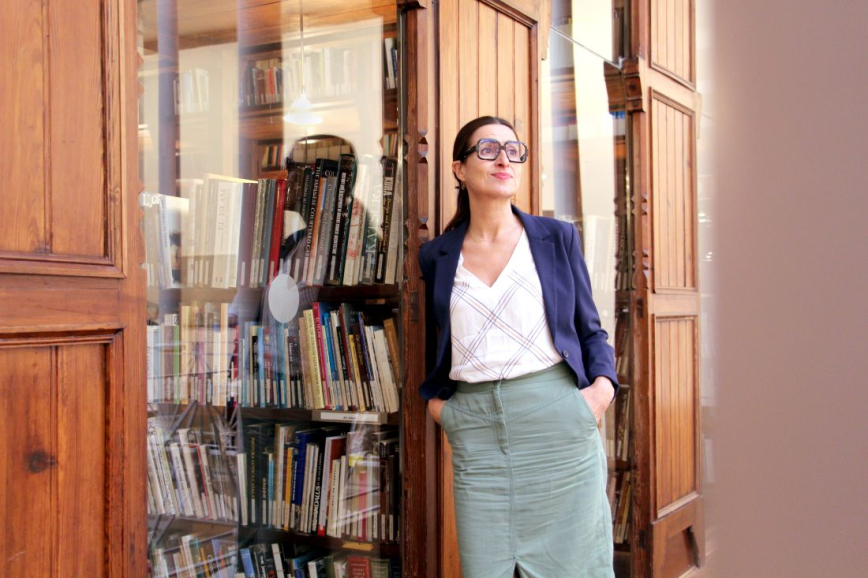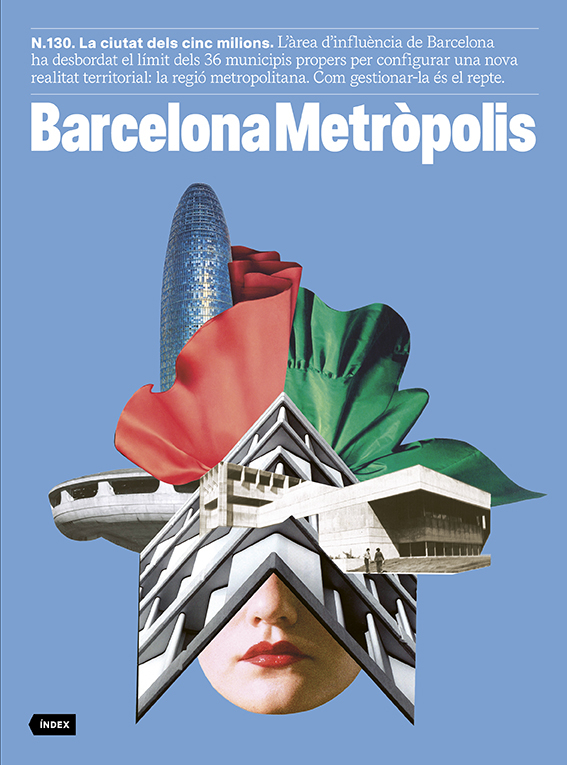“A museum should have the capacity to stimulate political and social discourse through its content”
- Interview
- Apr 24
- 13 mins
Imma Prieto

Imma Prieto (Vilafranca del Penedès, 1975) has embarked on her role as head of the Fundació Tàpies much like when she was appointed director of Es Baluard Museu d’Art Modern i Contemporani in Palma: with a slew of ideas to reimagine the institution and a meticulously detailed plan for its execution. As a curator, researcher and writer, her career has led her to curate numerous international and national exhibitions at venues such as MACBA and the Fundació Miró in Barcelona, the TEMP Art Space in New York, and the MUCA Roma [University Museum of Science and Art] in Mexico City.
When Imma Prieto took the helm at Es Baluard in 2019, the museum underwent a profound transformation. What initially started with a visual rebranding and structural renovations culminated in the establishment of this Mallorcan art centre as a prominent player on the contemporary art scene. Now, Prieto returns to Catalonia, having unanimously won the international tender to run the Fundació Antoni Tàpies, an institution without direction since 2020.
Having recently arrived at the Museu Tàpies, what are the initial challenges you’ve identified?
It’s enough to step outside the building and observe passers-by. Most of them aren’t aware of what the Fundació Tàpies represents. We must acknowledge that Tàpies’ figure has faded from the current consciousness, particularly among younger generations. But also on the international stage. While Tàpies may be a recognisable name in Catalonia, his name doesn’t carry the same weight outside the region, and even less so abroad. Therefore, there’s a crucial internal task of reengaging with Tàpies that needs to be reflected in our programming. But there’s also a relatively straightforward task I can undertake externally. I can articulate who we are – a museum. Simply by promoting the concept of the “Antoni Tàpies Art Museum”, we could make a significant impact. While we must maintain the foundation’s identity, it’s important to note that our statutes state “Museu Fundació Antoni Tàpies”. Fundamentally, we are a museum!
The first thing you did when you were appointed director of Es Baluard was to change its entire visual identity. Is this work necessary at Tàpies?
Communication, visual identity and signage are all parts of a museum’s identity. And it’s crucial to ask yourself what your identity as a museum is! The case of Es Baluard is very different from that of Tàpies because we’re talking about a centre for modern and contemporary art, and now we’re in a named museum, which is the Fundació Tàpies. At Es Baluard, the visual identity was completely blurred, and at Tàpies, we also need to address this issue, but not in the same manner. It’s not about making such a radical change, but rather about implementing necessary adjustments, considering we’re in an urban system saturated with visual stimuli. You step out onto the street, and there’s a hotel on one side and a Zara on the other. Signs and more signs everywhere. How can we stand out amidst all of this? An analysis is necessary to ensure that passers-by who know nothing about Tàpies, know what we are. Equally important is that those already familiar with us understand the scope of our activities. Currently, visitors entering the Fundació cannot see beyond the shop, as they are met with a wall.
So, do we need to carry out renovations as well?
Yes. However, we’re talking about a master plan that involves actions in the short, medium and long term. Unfortunately, this means we need budgets, which is what I’m working on right now. We need to raise funds that will not only support the implementation of exhibition content, activities and public programmes, but also translate into changes to the museum’s infrastructure.
What changes will Tàpies see from within?
Tàpies has long been associated with certain parameters that need updating. For me, it’s crucial not just to exclude but to embrace, and that means embracing the present. We already have our past within Tàpies because we’re a museum working with a legacy. Now, we need to reinforce that past to better articulate our present stance. This translates into a reorganisation of our team, a change that might not be immediately visible but is equally important. Going forward, Tàpies’ institutional architecture will be structured along a timeline.
Could you elaborate on that?
Within the museum, I see three distinct areas. First, there’s the realm of the past or memory, which encompasses the management of the Tàpies collection, along with the library, archives and publications. Understanding our identity and our place in history is crucial – it’s what sets us apart. We’re a named museum housed in a beautiful Modernista building that once served as a publishing house. This already provides us with insights and helps us stand out within the Barcelona ecosystem. Barcelona is home to a diverse array of institutions, and it’s crucial that we avoid duplication. It’s something I’m keen to avoid; we need to establish our own distinct identity and direction. That’s why the teams handling the collection, publications, library and archives all contribute to this facet of the museum that speaks to our history.
And who speaks for the present?
If we’re talking about the present, I want to delve into the concept of image and criticism, debate and dialogue. The present domain comprises exhibitions – those not part of the collection, but featuring contemporary artists –, education teams and public programme teams. Lastly, the third domain relates to the future and the ability to create new imaginaries. The management, administration, communication and maintenance teams all serve the past and the present, and together we shape the future. This is the new organisational structure.
You’re putting the maintenance team alongside management or administration.
Absolutely! It’s crucial. Having clean staircases and properly functioning lights are basic necessities. Just like the communication department, which serves all other teams, maintenance impacts all areas. A director without a team can’t accomplish anything, no matter how many ideas they have. But a team without direction can’t do much either, as direction provides the roadmap. My arrival has coincided with the upcoming centenary celebration scheduled for 2024. To ensure its success, specific actions must be taken.
How do you approach the centenary?
First and foremost, by questioning it. What’s the purpose of the centenary? Fundamentally, to talk about the future. Tàpies is more relevant today than he was in his own era. Many of his processes and interests, unbound by the present-day labels we’ve assigned, resonate deeply with contemporary concerns. These are the paths he paved, such as his reflections on recycling, matter and the environment. The reuse of materials is more pertinent than ever. Then there’s the iconographic dimension, which involves reassessing history. I want to challenge historiography. As a historian myself, I believe we sometimes pigeonhole artists excessively, inadvertently stifling the artists. If we aim to modernise, we should categorise less. Tàpies is a great universal artist. It’s a mistake to think in trinities, connecting the anniversaries of Miró, Picasso and Tàpies. Cubism dates back to 1905, while Tàpies emerges much later. He’s the eminent artist of the latter half of the 20th century.
What labels stifle Tàpies?
Perhaps it’s his profound humanism, which is often misconstrued. Tàpies explored astronomy, science, economics, but he also harboured a deep concern about the times he lived in, on both political and social levels; his humanism is deeply critical! Then there’s the issue of how his art has been interpreted. I’m currently reading texts written about Tàpies’ art, and they often regurgitate common tropes, which I’m not saying are entirely unfounded, but they don’t paint the whole picture. They tend to portray him through a favourable lens, overlooking his more critical side.
How can we shed this preconceived notion we have of him?
To reposition Tàpies, I’ve established four initiatives that will delve deeper into his persona and present him in a more multifaceted light. Firstly, I’ve spearheaded the creation of the Antoni Tàpies Chair at Pompeu Fabra University, encouraging students to write theses on Tàpies, but from a contemporary standpoint, far from the informalist readings that have traditionally prevailed! We need to view the world through the lens of Tàpies and understand his legacy as an essayistic endeavour. In addition, we’re striving to create an international postdoctoral research prize. With this, I aim to thrust Tàpies into the forefront of international discussions on criticism, image and time. Art is rarely self-referential; or, at least, that aspect of art doesn’t pique my interest much. Art is a way of understanding the world. And Tàpies has made it very easy for us, as he saw it the same way. Even in the works where he appears, he delves much deeper, invariably creating pieces that reflect a time and a space, some sufferings, a fracture. The chair and the international prize will enrich these interpretations of the artist in academic circles. Yet, I also aspire for younger generations to contemplate Tàpies and, in turn, cultivate critical writing in schools.
And how do you accomplish this?
By organising a competition designed specifically for primary, secondary and post-compulsory secondary school students. While I have nothing against technology, there’s a global trend where not only is writing becoming less common, but there’s also a decline in critical thinking. Our objective is to foster critical thinking through the exploration of Tàpies’ work, viewing it as a means of understanding the world.
What does criticism mean to you?
It’s an exercise in dialogue that compels us to step out of ourselves. There’s a fabulous text by Oscar Wilde from the late-19th century where two characters discuss the nature of criticism and its origins. One character asserts that criticism began with the Greeks. The other counters, noting that during that era, the press didn’t even exist; what did exist were the Dialogues of Plato. And that’s what criticism is. It’s a dialogue, an attitude that inherently requires stepping outside oneself and engaging with others. Through this competition, my goal is to revive dialogue and connect with younger generations, where the finest texts will ultimately be compiled into a book that can be purchased. Tàpies also facilitates this process for us. Since the 1960s, during the dictatorship, he paid great homage to educators and participated in publications like Cavall Fort, a publication Vox threatened in Valencia in 2023. Tàpies had this pedagogical aspect deeply ingrained.
We have the chair, the international prize and the student criticism contest in place, but we’re still missing the fourth element to rethink Tàpies.
The latest addition to these initiatives is the Institut de les Derives Crítiques, where six or seven local and national researchers will gather four or five times a year behind closed doors. However, this doesn’t mean it’s entirely closed off; if someone wants to join, they can request it. But we prefer to avoid the pressure of public scrutiny to allow for the freedom to make mistakes. We’ve already got confirmed participants, ranging from Manuel Borja-Villel to Xavier Bassas, and including Andrea Soto, Mabel Tapia… The plan is to record these meetings and potentially edit and publish them in the future.
You mentioned earlier that the city has all sorts of stimuli. We also boast numerous museums. What unique contribution can Tàpies make to Barcelona’s museum scene that hasn’t been discussed yet?
We need to approach this from a contemporary standpoint while still honouring his legacy. Thus, I aim to ensure that the contemporary artists we showcase align with Tàpies’ legacy. Any exhibitions or activities not directly linked to Tàpies will initiate from a dialogue with his work.
 Portrait of Imma Prieto © Eugènia Güell
Portrait of Imma Prieto © Eugènia GüellSuch as?
Here, we’re fitting in an exhibition on the East, topics that interest Tàpies. That’s why we’re featuring Chiharu Shiota, a contemporary Japanese artist who delves into themes like memory and employs symbols such as chairs. The connection to Tàpies is indisputable, which is why we’ve commissioned her for a site-specific piece to be displayed on Floor –2. Another instance of connecting contemporary artists to Tàpies’ narrative is the installation we’ll unveil on the facade in July. I aim to delve into the dual meanings of the building housing our institution, approaching it through a critical lens. We cannot deny that a part of Catalan Modernism was financed by the slave trade, and therefore, we’ve invited Serge Attukwei Clottey, an artist from Ghana, to transform our facade. His artworks are interventions in spaces; he covers them with a yellow mosaic made from plastic tiles sourced from the yellow jerrycans used to store oil and water in Accra, where he resides. It’s a reflection on the environment and migration, resonating with Tàpies’ approach of reusing materials we wouldn’t consider noble. That’s why I’m eager for him to work on our building, turning it into a porous skin. We are still deciding which parts of the building to cover! These artists exemplify how, without straying from Tàpies, I can incorporate contemporary art. Yet, we also owe it to history to address the gaps, particularly regarding overlooked artists, especially women. Hence, we’re preparing to showcase the works of Marta Palau, a Catalan artist born in Lleida, exiled in Mexico in 1941, and who passed away August 2022. She never returned to Catalonia, but her works undeniably evoke Tàpies’ artistic style.
Making all this a reality hinges on budgetary constraints. How do you prioritise when preparing these budgets?
At present, Tàpies’ budget falls short, not just for my programme, but for anyone aiming to comprehensively revamp the institution. It’s vital to assess the scale we’re operating on. We’re a mid-sized institution, not on the scale of MNAC or MACBA, yet the budget must be adjusted accordingly. Currently, it is inadequate; we’re working with the budget of a smaller institution, despite not being small ourselves. This calls for a dialogue with the board of trustees to align them with our new vision. Furthermore, our internal resources, which rely on ticket sales and other activities, are insufficient and require improvement. That’s why a rebrand is necessary too! Positioned in a place where we’re contending with tourist hotspots like Casa Batlló, it’s a competitive landscape. Strengthening private sponsorships is also high on my agenda.
Could you give me a definition of a museum?
I’ll share the one from ICOM. When they were working on defining a museum, there were challenges reconciling two perspectives: one more conservative and the other more contemporary. Progress was made toward embracing the contemporary view, leading to the current definition reached in 2022 in Prague. It describes a museum as a not-for-profit, permanent institution in the service of society that researches, collects, conserves, interprets and exhibits tangible and intangible heritage. What’s more, it underscores aspects such as accessibility, inclusivity, diversity, sustainability and the museum’s role in offering enjoyment, knowledge sharing and education to the public.
It’s quite a politically charged definition.
Absolutely. “Politics” stems from “polis”, which means “city”. Every living creature is political; as soon as we acknowledge our existence within society, we become part of politics. And a museum is part of it because it should have the capacity to stimulate political and social discourse through its content. In our context, we must navigate this while keeping our museum’s specific identity in mind. Yet, as I mentioned, Tàpies already did all this through his artworks and writings.
The newsletter
Subscribe to our newsletter to keep up to date with Barcelona Metròpolis' new developments




